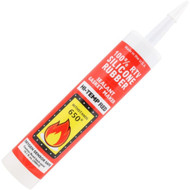Finding the Best Fire-Resistant Sealant for Your Project
Jul 18th 2024
Stopping the flow of fire and smoke and preventing the degradation of key structures within a building can give first responders and clients precious moments and save lives. By using fire-resistant sealant, you can help reduce danger in the case of a fire.
However, not every fireproofing technique is equally effective. It’s important to understand which types and techniques meet the requirements for each type of insulation to stay in code.
Fireproof Sealant vs Fire-Resistant Sealant
Fireproof sealant fortifies the building's structure. By creating seams with fireproof sealant on key structures within the building, you can slow the structure's degradation by self-extinguishing or slowing the spread for a certain amount of time. Most products list this time on the sealant.
Alternatively, you use fire-resistant sealant or fire-stop sealant to prevent airflow that would otherwise encourage the spread of fire and smoke. Most often, you find this type of sealant around holes in beams where electrical outlets, HVAC systems, or other penetrants run through. Though it may not be able to stop a fire when it starts, it's an important preventative measure that several certifications require.
What are the Requirements for a Quality Sealant?
Finding the best fire-resistant sealant begins with finding a product that meets or exceeds the various standards needed for building-grade materials. Standards such as UL 2079, ASTM E814, and UL 1479 all focus on fire safety products, such as fire-resistant sealants.
When choosing a sealant for your fireproofing needs, sealants clearly marked with theUL logo will ensure compliance. However, they can be incredibly expensive.
Silicone sealant offers a great alternative option for fireproofing. A premium, neutral-curing silicone sealant can resist flames for up to four hours. This means it performs just as well as other brands of sealant specifically designed for fire resistance without the exorbitant price tag.
Usages Of Fire-Resistant and Fireproof Sealant
You should apply firestop or fireproofing in any project that has a risk of flammability. Though many people consider homes and other commercial buildings to be the only place where this type of sealing is important, this is not completely true. In addition to buildings, you might need fire-resistant andheat-resistant sealants when working on RVs, cars, boats, electrical projects, and more.
One of the most common places to use a fire-resistant sealant is fire-rated walls. These walls have a high level of fireproofing, which can make a huge difference in how a fire develops. These rated walls will often contain multiple forms of fireproofing, such as insulation, in addition to proper sealant. When designing, use fire-rated sealant around all cracks, openings, outlets, and doorframes that are part of the wall.
Another example of using a fireproof sealant is in concrete structures. Concrete is one of the most commonly used building materials in commercial development. It's a sturdy material but can shrink or expand during extreme heating or cooling, which can cause cracks. These cracks threaten the structure of the building. However, using fireproof sealant as a construction joint gives the walls extra protection when exposed to extreme temperatures and reinforces their stability.
Ideally, the fireproofing sealant should be in places where you don't want the fire to travel. This includes areas around outlets, in key structural locations, and in appliances that use a flame, such as ovens. Alternatively, fire-resistant sealant fills cracks that allow smoke to flow out and air to flow in. This prevents the fire from growing or affecting other areas.
Choosing the Right Fire Rating
Depending on the type of project and materials you’re using, you will need to choose a sealant with a specific fire rating. There are two different classifications for fire rating: the ASTM E-84 rating and the ASTM E-119 rating.
Testing fire-resistant products on the ASTM E-84 scale involves observing the amount of smoke that flows through a fire-resistant material and how much the flame spreads, also known as the flame index. They then place them in Classes I-III, depending on their performance, with Class I being the best. The baseline for meeting this certification is a smoke development rating of 450, and the flame index ranges between 25 and 200.
In the ASTM E-119 system, they test fireproofing materials on their resistance to flame. They then assign a rating, that corresponds to how many hours the fireproofing was able to withstand the flame. Different construction types require different fire ratings. Common fire-resistant materials, such as firestop, offer a rating of 2-3.
This is another excellent reason to use silicone sealant for fireproofing. As mentioned before, neutral-cure silicone sealant has a rating of 4, meaning it will pass inspection for ASTM E-119. It also has a Class I fire rating on the ASTM E-119, with a smoke rating of 20 and a flame spread index of 0. This makes it a great option for general contracting due to its durability and impressive flame resistance.
Buying Fire-Resistant Sealant
Understanding the usages, best practices, and conditions surrounding fire-resistant sealant means you can make the best choice possible. Whether you're a professional contractor or relatively new to the industry, it’s important to prioritize quality and accessibility.
At Silicone Depot, we’ve been providing the best silicone sealants to construction professionals everywhere since 1978. Enjoy peace of mind knowing that you can shop for high-quality, durable silicone products, as well as all the associated tools in one place. If you want to learn more about the power of silicone sealant for your projects,call us at 812-824-8000.

